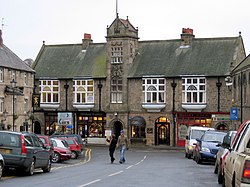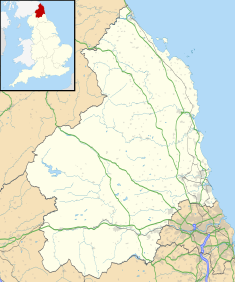| Corbridge Town Hall | |
|---|---|
 Corbridge Town Hall Corbridge Town Hall | |
| Location | Princes Street, Corbridge |
| Coordinates | 54°58′27″N 2°01′02″W / 54.9742°N 2.0172°W / 54.9742; -2.0172 |
| Built | 1887 |
| Architect | Frank Emley |
| Architectural style(s) | English Renaissance style |
| Listed Building – Grade II | |
| Official name | Town Hall with shops |
| Designated | 15 April 1969 |
| Reference no. | 1044757 |
 | |
Corbridge Town Hall is a municipal building in Princes Street in Corbridge, Northumberland, England. The building, which is now in commercial use, is a Grade II listed building.
History
In the mid-1870s, a group of local businessmen decided to form a company to raise funds for the erection of an events venue in the town in order to celebrate the Golden Jubilee of Queen Victoria. The site they selected was a focal location in the town facing the top of Hill Street.
The building was designed by Frank Emley in the English Renaissance style, built with snecked masonry at a cost of £2,000 and was officially opened on 18 June 1887. The design involved a symmetrical main frontage with five bays facing onto Princes Street; the central bay, which slightly projected forward, featured a three-stage tower with an arched doorway with an architrave and a keystone in the first stage and mullioned and transomed windows in the second and third stages, all surmounted by a cornice, a parapet and a pediment with a projecting flagpole and finials. In the outer bays, there were doorways with architraves and keystones, and, in the fourth bay from the left which was rusticated, there was a doorway and a rounded headed window. There were for large oriel windows on the first floor. The ground floor was designed for retail use while, on the first floor, there was an assembly hall which was capable of accommodating 500 people.
The architectural historian, Nikolaus Pevsner, liked the design which he described as "pretty" and "Norman Shavian" the latter being a reference to the architectural style of Richard Norman Shaw. The building was primarily used for community events with the Corbridge and District Gardeners' Society being typical of the various organisations which regularly used the building.
However, activity reduced in the second half of the 20th century and in the late 1970s the company that had originally developed the town hall got into financial difficulties and was wound up. After the company's assets, including the building, had been sold community activities were transferred to Corbridge Parish Hall in St Helen's Street, and the town hall was put to commercial uses including café, art gallery and restaurant.
References
- Historic England. "Town Hall with shops (1044757)". National Heritage List for England. Retrieved 16 March 2022.
- "Corbridge". England's North East. Retrieved 16 March 2022.
- "Corbridge Town Hall Co Ltd: Records 1886-1943". National Archives. Retrieved 16 March 2022.
- "Conservation Area Character Appraisal" (PDF). Tynedale Council. 1 March 2009. p. 24. Retrieved 16 March 2022.
- ^ The Monthly Chronicle of North-country Lore and Legend. Vol. 1. W. Scott. 1 August 1887. p. 287.
- "Corbridge". Keys to the past. Retrieved 16 March 2022.
- Pevsner, Nikolaus; Grundy, John; Ryder, Peter; McCombie, Grace; Welfare, Humphrey (1992). Northumberland (Buildings of England Series). Yale University Press. p. 238. ISBN 978-0300096385.
- Corbridge and District Gardeners' Society. Vol. 26. Journal of Horticulture and Cottage Gardener. 9 February 1893. p. 112.
- "No. 47784". The London Gazette. 1 March 1979. p. 2830.
- "Corbridge Parish Hall". West Northumberland Community Buildings Consortium. Archived from the original on 13 March 2015. Retrieved 16 March 2022.
- "Town Hall Buildings, Corbridge: Heritage Design and Access Statement" (PDF). Northumberland County Council. 1 October 2021. Retrieved 16 March 2022.
- "New restaurant planned for Corbridge". Hexham Courant. 3 November 2021. Retrieved 16 March 2022.